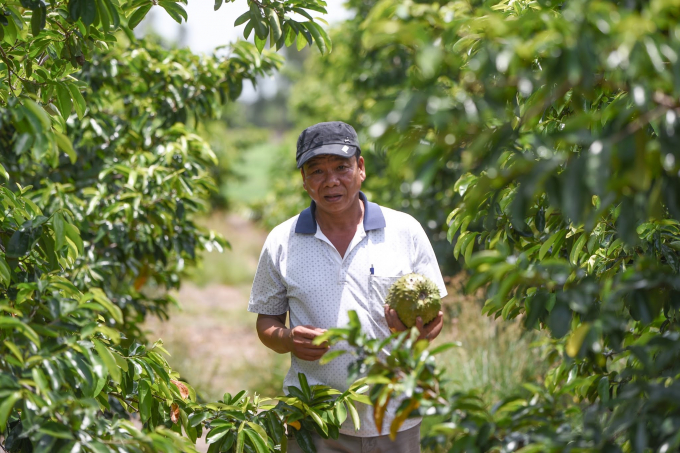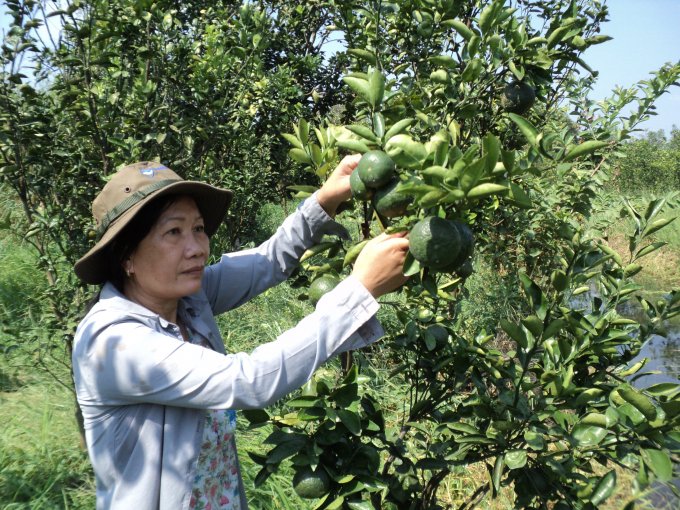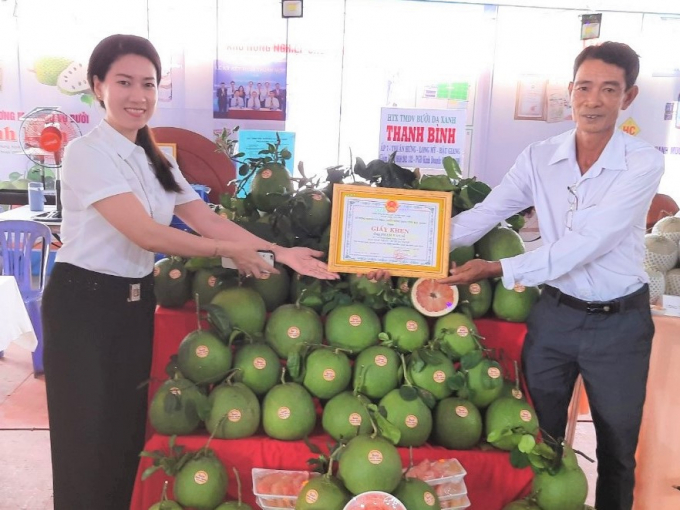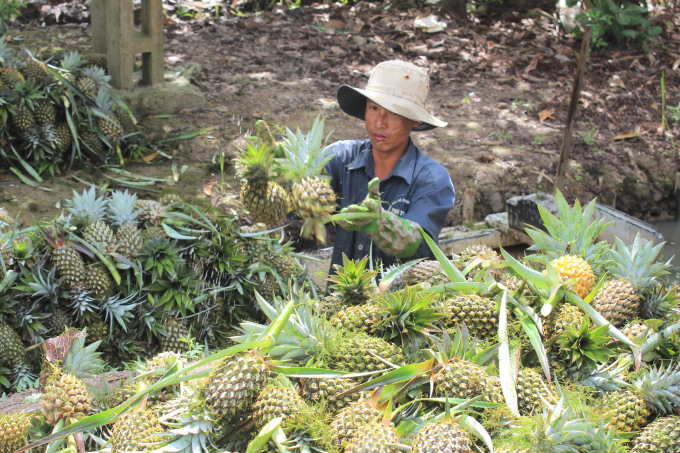December 5, 2025 | 17:53 GMT +7
December 5, 2025 | 17:53 GMT +7
Hotline: 0913.378.918
December 5, 2025 | 17:53 GMT +7
Hotline: 0913.378.918

Soursop of Hau Giang granted the certificate of trademark registration, is planted and processed into tea and jam. Photo: Trung Chanh.
Referring to Hau Giang's fruits, there are eight most well-known types of fruits including Phu Thanh pomelo, Nga Bay king orange, Cau Duc pineapple, Hau Giang seedless-lime, Long Tri sugar tangerine, Phung Hiep mandarin, Hau Giang sweet mango and Hau Giang soursop. Up to now, all eight types of fruits were granted the trademark registration certificates. Specifically, soursop of Hau Giang has got the certificate of collective brand.
Deputy director of Hau Giang's Department of Agriculture and Rural Development Nguyen Thi Giang said so far the province has granted the VietGAP certificate to over 164 hectares of fruit crop, including pomelo, orange, tangerine, durian, soursop and pineapple. Sixty hectares of fruit cultivation are granted the GlobalGAP certificate including pomelo and seedless lime. The province is preparing document to grant the VietGAP certificate to seventy-seven hectares of pomelo and orange trees and putting 40 hectares of pineapple and soursop trees into production under the GlobalGAP standards.

Fruit industry plays an important role in Hau Giang's economy in which citrus is the fruit crop of the largest cultivation area. Photo: Trung Chanh
In the coming time, Hau Giang will focus on building infrastructure synchronously for developing fruit plantation areas, granting growing area codes. Promoting the links between fruit cooperatives and processing businesses inside and outside the province. At the same time, calling enterprises for building manufactures to process fruits and fruits by-products in association with the plantation areas .
Speeding up the application of science and advanced technologies, saving water in production, improving the quality and appearance of fruits, Strengthening intensive agricultural activities in order to quickly change custom practices for production; following the standards of VietGAP, GlobalGAP to produce safe and high-quality products meeting the export requirements.
Director of OCOP Bio-Fruit Cooperative (Chau Thanh district, Hau Giang province), Tran Ba Son said currently, the cooperative is linking with about 100 households cultivating pomelos and seedless limes under the standards for exports in a chain. In 2021, the cooperative sets the target to export around 1,600-2,000 tons of fruits including limes and pomelos. The US, Russia and the European countries are the largest partners for Vietnamese export of fruits.

Pomelo, one of the Hau Giang's eight well-known fruits, is now cultivated and get the VietGAP, GlobalGAP certificates. Photo: Trung Chanh
To increase value for exported fruits, OCOP Bio-Fruit Cooperative has boldly invested in the project of processing fruits with a total capital of VND 23 billion. Hau Giang's provincial People's Committee has approved the project. The project is deployed in Tan Phu Thanh industrial zone (Chau Thanh A district, Hau Giang province). In the first phase, the project area encompasses 1.5 hectares with a design capacity of 20,000 tons per year.
The processing of exported fruits applies advanced methods and technologies. Machines, equipment used are made in Vietnam and Taiwan. The factory will provide fresh and processed fruits and frozen fruit products to overseas markets as well as domestic supermarkets.

Pineapple is a popular fruit crop in Hau Giang with the famous brand "Cau Duc Pineapple". Photo: Trung Chanh.
Currently, fruit industry plays important role in Hau Giang' s economy. Among 8 types of fruits granted the certificate of trademark registration, seedless limes give growers a high economic efficiency. As of 2020, Hau Giang had 2,923 hectares of seedless limes trees of which the area harvested is 1,735 hectares with estimated production at 31,230 tons.
For the plantation of seedless limes in Chau Thanh district in the Thanh Phuoc cooperative's raw material area, over 17 hectares are granted the VietGAP certificate, ensuring quality for export.
The National Office of Intellectual Property of Vietnam granted the certificate of trademark registration " Hau Giang seedless lime". Besides, Thanh Phuoc Cooperative has linked with the Fruit - Republic(Netherland) to grow limes meeting the standards of GlobalGAP. The company granted the certificate for 12 households with 13 hectares and signed contract to export limes to Singapore.
To create favorable conditions for Hau Giang province to export agricultural products to overseas markets, especially China, the agricultural sector has reviewed and granted plantation area codes for fruit crop regions. So far, the Plant Protection Department under the Ministry of Agriculture and Rural Development has granted 117 growing area codes for export to the Chinese market to the agricultural products such as mangoes, jackfruits, rambutants, bananas, longans and watermelons in localities of the province.

(VAN) After three years, Project FST/2020/123 collected approximately 3,000 insect specimens, classified them into about 50 morphological groups, and identified around 40 species, including several new species.
/2025/12/01/0509-2-175427_206.jpg)
(VAN) Emission-reducing coffee areas in Lam Dong have entered the new crop with stable yields, improved quality, and a remarkably enhanced cultivation environment.

(VAN) The Institute of Agricultural Sciences for Southern Vietnam (IAS) marked its 100th anniversary in Ho Chi Minh City, celebrating a century of growth as a leading institute contributing significantly to Viet Nam’s agricultural development.

(VAN) An increasing number of livestock farms are using biogas generators to create a source of renewable electricity, helping to save costs and mitigate environmental pollution.

(VAN) Small changes in rice cultivation, from irrigation methods and straw collection to input management, are paving a new way for Vietnam's agriculture in the journey toward emission reduction.

(VAN) With the project of converting biogas into renewable electricity, Australia is both helping pig farms reduce their energy costs by up to 25% and contributing to environmental protection.
![Hue aims for Net Zero: [1] Initial steps from green transportation](https://t.ex-cdn.com/nongnghiepmoitruong.vn/608w/files/huytd/2025/11/28/0853-anh-6-giao-thong-xanh-hue-094717_940-153724.jpg)
(VAN) For sustainable development, Hue City is implementing many solutions to promote green transportation, which is an important initial step on the journey to building a Net Zero Hue.